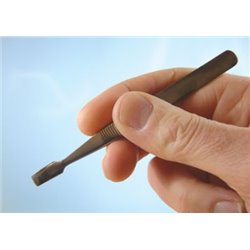Static grass puffer bottles work by manually charging model grass fibres with static electricity. When the charged...
No products
Product successfully added to your shopping cart
There are 0 items in your cart. There is 1 item in your cart.
Search Tips
How do I add simple paint chips with a foam sponge ?
When assembly and painting of a model are completed, many modellers will wish to add some degree of wear and tear to add a little extra realism. One simple technique to achieve this is by using paint chips via a foam sponge. This can be used to add rust or simply indicate where surface paint has been removed, thus exposing the underlying metal surface of the model.
Foam kitchen sponges or similar materials are ideal for this process. Simply tear of a corner from the sponge. The torn section will have a randomly shaped surface and it is this random effect that we will use to achieve the desired chipping effect.
Once the final top coat of paint has been applied we can then add the chipping effect. At this stage the modeller will need to decide what particular effect they are looking to create. Underlying metal surfaces can be achieved with colours such as black or aluminium, similarly, light rusting can be achieved via various tones of reddish-brown. Once the desired colour has been chosen, simply dab the random surface of the sponge into the desired colour. The sponge should be gently dabbed onto a paper towel or rag to remove as much excess paint as possible. This is because the chipping effect we are looking to achieve will look much more realistic if it is gently built up with small amounts of paint. In effect, less is more!
Holding the sponge in a pair of tweezers is the best way to apply the chipping effect to the required location. Access panels and doors are great places to apply the effects, as these will effectively mimic areas of natural wear and tear on the vehicle in question. Other good options can be running boards, footwells and handholds or other similar locations that are in regular use and as such are more likely to suffer work related wear and tear to surface paint.
Click here to receive the tips weekly in your mailbox. You can unsubscribe at any time.










